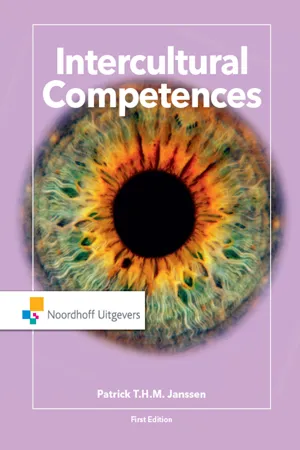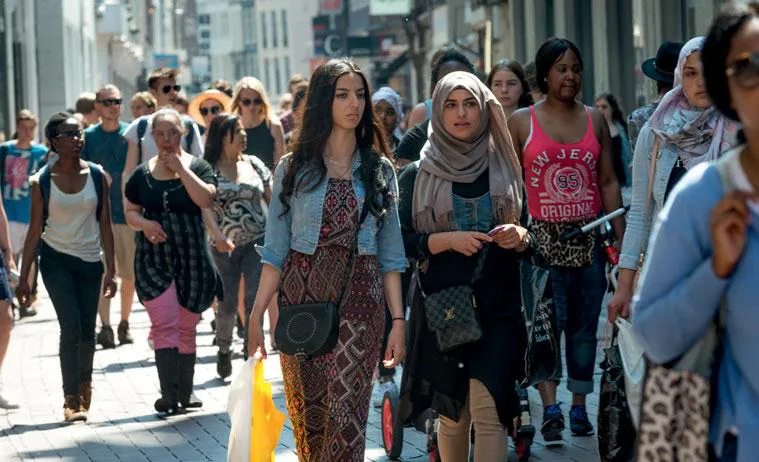
This is a test
- 240 pages
- English
- ePUB (mobile friendly)
- Available on iOS & Android
eBook - ePub
Intercultural Competences
Book details
Book preview
Table of contents
Citations
About This Book
In a multicultural environment, having intercultural competences is the most important determining factor between success and failure.
This concise book introduces the topic for students and scholars. Building upon an accessible understanding of cultural differences, the author provides various models for understanding and framing culture. Theory is linked to practice by examining how to deal with intercultural conflicts via practical examples and advice.
Students striving to perform well in intercultural environments, will benefit from reading this book which helps them convert models and cultural knowledge into practical skills.
Frequently asked questions
At the moment all of our mobile-responsive ePub books are available to download via the app. Most of our PDFs are also available to download and we're working on making the final remaining ones downloadable now. Learn more here.
Both plans give you full access to the library and all of Perlego’s features. The only differences are the price and subscription period: With the annual plan you’ll save around 30% compared to 12 months on the monthly plan.
We are an online textbook subscription service, where you can get access to an entire online library for less than the price of a single book per month. With over 1 million books across 1000+ topics, we’ve got you covered! Learn more here.
Look out for the read-aloud symbol on your next book to see if you can listen to it. The read-aloud tool reads text aloud for you, highlighting the text as it is being read. You can pause it, speed it up and slow it down. Learn more here.
Yes, you can access Intercultural Competences by Patrick Janssen in PDF and/or ePUB format, as well as other popular books in Business & Business General. We have over one million books available in our catalogue for you to explore.
PART 1
What is culture?
Part 1 of the three parts in this book deals with the awareness of what culture really is and how culture is interwoven with our daily lives. Part 1 provides the basic background for a better understanding of Parts 2 and 3.
1 Dynamic definition of culture
It is difficult to give a single, fixed definition of culture. Thus a ‘dynamic definition of culture’ makes clear that culture can have many forms but is bound to a number of conditions and characteristics. In Chapter 1 – What is culture? – a conceptual framework is given within which ‘culture’ can be described, insight is provided as to what culture is in daily life and an explanation given as to what is meant by culture in this book.
2 Where does culture come from?
Chapter 2 explains how the cultures of the world as we know them have come about. The origins of our cultures range from 200,000 to 40,000 years old in Africa and Europe respectively. When people fanned out across the globe different groups made different choices with regard to solving the problems they faced; the process of making those choices (that led to tangible consequences in the form of cultural expression) is discussed.
3 Cultural identity
Ultimately, this book is about the competencies required to interact with people from another culture; this can only take place successfully once it becomes clear who someone is and what their most important values are. Individual people do not belong to one specific culture but are part of multiple cultures within a society. The concepts of country culture, identity, subculture and stereotype are explained.

1
Dynamic definition of culture
1.1 Introduction
Culture is a concept that is difficult to pin down and there is no single, all-encompassing definition. When people talk about culture the meaning depends on the context; for example, in the corporate world people often talk about ‘company culture’, but groups in society can also have their own ‘subcultures’ such as students, football supporters or hard-rock fans. In addition, there is the more general concept of culture which usually refers to the country or society that people grow up in.
This chapter sets forth some important terms and definitions that are necessary to better understand the concept of culture and the contents of this book. Culture is not meant to be art; visual art, song, dance & drama are not definitions of culture as discussed in this book.
Culture determines a much larger part of our lives than we think or would like to believe. How we define culture depends on a number of things. This chapter does not give a single definition, but a conceptual framework to get a workable definition of culture.
Awareness (what do I know)
• That culture is a complex concept for which there is no single definition.
• That culture has a number of properties and boundaries.
• That our culture determines a very large part of who we are and what our life looks like.
• That misunderstandings may arise because people from other cultures might impose a different meaning on things we think of as normal.
Knowledge (models, concepts, theories)
• A conceptual framework of what culture is and what it is not.
Competence (what can I do)
• Understand the limits of what culture is.
• Recognise culture and cultural issues in daily life.
• See and explain what aspects of daily life are determined by culture.
• Be able to recognise your own comfort zone.
David’s diary
The text below is an excerpt of the book Alleen maar nette mensen (Only decent people) from Robert Vuijsje (2011). It gives a direct, streetwise image of how cultural groups in the Netherlands see each other.
The multicultural society
People called ‘immigrants’ think all day long about what it means to belong to a group of people called immigrants; with every social interaction they are reminded that they are not in their own country.
Dutch people never think about what it means to belong to a group of people which they call immigrants.

The group of people called immigrants want to know exactly who you are.
For the Dutch it does not matter what group someone else belongs to – they are all in the group called immigrants.
Dutch people see no difference between an Antillean and a Surinamese, or even between a Turk and a Moroccan.
Turks are angry with Moroccans because they give them a bad name.
For the same reason, Surinamese negroes resent Antilleans because they wear too much gold, do not speak Dutch and are stupid. All ugly slaves were put out of the boat on Curaçao. The beautiful slaves were allowed to sail to Suriname.
According to Antilleans, Surinamese think that they are the elite.
When a Dutchman forms a new relationship with someone that belongs to the group of people they call immigrants, everyone knows he was unable to ‘do better’. Surinamese negroes think that Surinamese Hindus are arrogant.
Hindus find negroes lazy and stupid.
Dutch people think that all South American, African, Eastern European and Asian women living in the Netherlands are whores.
Antilleans from Curaçao believe that Arubans are arrogant because they have lighter skin.
Arubans think that Curaçaoans are lazy and stupid – they give Antilleans a bad name because they are all criminals.
For Dutch people it is normal to crack jokes about lazy Africans who always arrive late to appointments and about Moroccans who lie and steal. They never do this in the company of people they call foreigners.
Another Dutch joke: black men cheat on their wives every day while Dutch men do not cheat, they just go to whores. Easier, safer and cheaper in the long run.
City negroes say that Bush negroes are retarded natives. City negroes come from Paramaribo (the capital of Suriname, red.), Bush negroes come from the interior of Suriname. Bush negroes believe that city negroes think they are elite.
Israelis believe that Dutch Jews are sissies meaning if they had lived in Europe in the Second World War they would have taught those Germans a lesson.
Dutch Jews find Israelis barbarians who treat Palestinians in a horrible way.
Dutch people from the Amsterdam know that Dutch people from the south always lie because they are Catholic. They also know that people from the north and east are backward farmers.
All Cape Verdeans live in Rotterdam. Nobody sees the difference between a Cape Verdean and an Antillean. Cape Verdeans are angry because Antilleans give them a bad name.
Dutch people subconsciously assume that the people they call immigrants are less clever and diligent than native Dutch.
People who call themselves immigrants know that they are always disadvantaged at school and in the workplace.
Negroes think of slavery every day, but no-one outside this group ever thinks of it. Jewish people think about the Second World War every day, but no-one outside this group ever thinks of it.
Dutch people know that Jews are stingy and think they should stop mentioning the war. Jews do not trust the Dutch. What happened in the Second World War can happen again.
Only then does it not happen to Jews but to Moroccans.
Surinamese and Antilleans think Africans are rough, rude and too black. They dance strangely and live with 20 people in a single flat. African men are rapists who do not know that No means No and always want paid sex with little girls. African women have moustaches, beards and bad skin.
According to Africans, Surinamese and Antilleans think they are better, just because they speak Dutch.
People from Amsterdam look down on the rest of the Netherlands while the rest of the Netherlands think people from Amsterdam are arrogant.
It’s not just Turks; all people the Dutch call foreigners are angry with Moroccans, because they give all foreigners a bad name.
Moroccans are angry with everyone.
Robert Vuijsje, Alleen maar nette mensen, Nijgh & Van Ditmar, Amsterdam 2011.
1.2 Culture is connected to a group
Culture always relates to a group of people, but that group of people can vary. People are always part of various groups that each have their own culture. Someone who lives in the Netherlands is a ‘Dutchman’, but also a ‘European’ or a ‘Frisian’. In addition, someone can feel connected to their city or neighbourhood.
Beyond identifying yourself with a country, you – as an individual – belongto various additional cultural groups or subcultures. You belong to the youth or the elderly, you belong to a certain religion or ethnicity, you belong to the supporters of a certain football club and so on.
Subculture
Everyone is a member of multiple subcultures most of which will exist perfectly alongside each other. For example, you might be male, 19 years old and born in the countryside with parents born and raised in the Netherlands; you play football, love dance music, enjoy drinking beer with friends and study at university in Utrecht. There are at least eight subcultures present here.
But some subcultures may not line up so well together, which can lead to problems for people who have to deal with this. Think of adopted dark African children who grow up in No...
Table of contents
- Cover
- Title Page
- Copyright Page
- Preface
- Table of Contents
- PART 1 What is culture?
- PART 2 Acquiring knowledge: the science behind culture: models and theories
- PART 3 Learning competences: intercultural communication in practice
- About the author
- Literature
- Acknowledgements
- Register